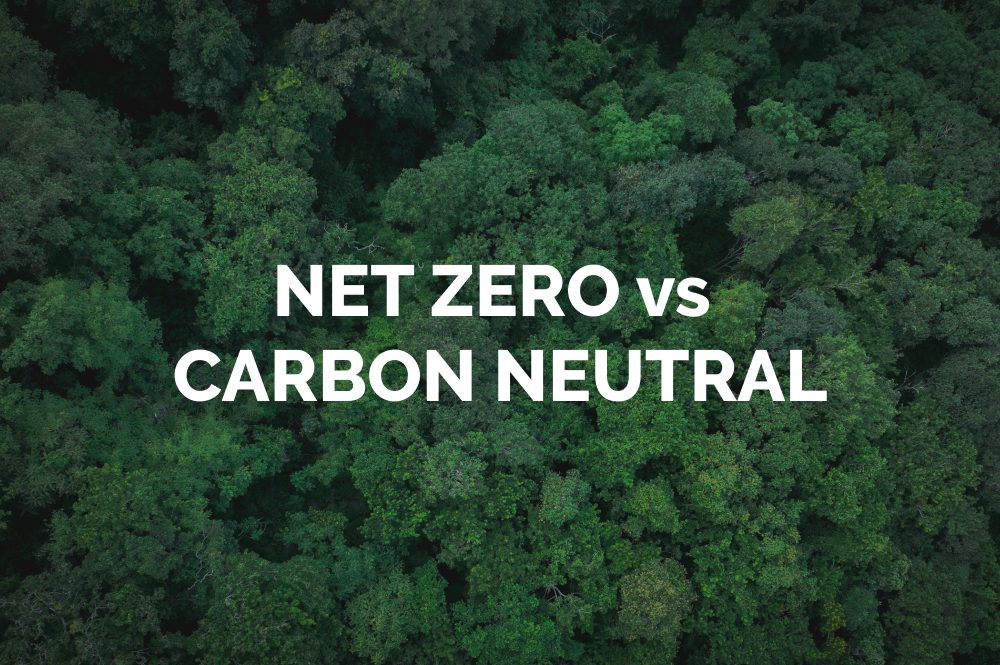Carbon Neutral and Net Zero – A Guide to Differentiation

Net Zero and Carbon Neutral have the same end goal, to remove harmful emissions from the atmosphere; however they are not interchangeable, especially when used on a large scale as they can have different impacts on global warming.
A Word on Carbon Threshold
The Intergovernmental Panel for Climate Change (IPCC) set a limit for global temperature warming to 1.5°C during the Paris Agreement, which was signed by 195 countries. It is hoped that by reaching this goal, climate change impacts on humans and ecosystems will be reduced.
Carbon Neutral: Explained
Carbon Neutral refers to any organisation that offsets the same amount of carbon (CO2) that they emit. Organisations use carbon sinks which absorb and store CO2, including forests, soil and oceans to offset their emissions; paired with investing in renewable energy and lower-carbon technology.
However, there are a couple of issues with going solely carbon neutral. Firstly, no carbon sinks are able to remove enough carbon from the atmosphere on the scale needed to fight global warming. Secondly, going carbon neutral won’t keep the world under the 1.5°C target, although it is a good place to start.
Additionally, to achieve carbon neutrality, a company (legally) only needs to ensure that they do not increase their carbon emissions, and then purchase carbon offsets to balance the emissions that they produce. This means that organisations can continue to produce the same amount of existing carbon, which does not tackle climate change head-on. Although carbon neutral certifications can be used to specify that the company meets their reduction targets, these do not specify by how much, leading to organisations being ambiguous and moulding the guidelines to their benefit.
How Does Carbon Neutral Work?
For organisations that do want to become carbon neutral, there are a number of processes that they can adopt. First, they should cut down on allunnecessary emissions to reduce their carbon footprint, followed by offsetting what’s left.
Net Zero Carbon: Explained
Net Zero refers to reducing all greenhouse gas emissions as much as possible – including carbon dioxide (CO2), methane, nitrous oxide and sulphur dioxide – and offsetting the essential emissions. Going net zero will help us to ensure the global temperature rises less than 1.5°C.
How Does Net Zero Work?
Organisations that wish to be net zero must ensure that they emit no new greenhouse gases into the atmosphere. They will need to eliminate all emissions produced to almost zero, then offset only the essential emissions that remain.
This is a lengthy/laborious process and is therefore a long term goal for any organisation. Although there are many guidelines for net zero, there are little proven ways to justify why a company’s remaining emissions are impossible to reduce, which can leave room for misinterpretation.
Difference between Carbon Neutral and Net Zero
As there are no set levels for the reductions that an organisation must reach, going carbon neutral could mean they continue to produce significant emissions. Furthermore, carbon neutral only refers to gas emissions that an organisation directly emits, not taking into consideration the outside activities that the organisation connects with.
In comparison, net zero takes into account both what the organisation directly emits and its entire value chain, from supplies to a product’s end of life treatment.
Conclusion
Aiming for carbon neutrality is a great place for an organisation to start, as it will help to reduce carbon emissions before starting to offset. However the long term goal should be to meet net zero, to stabilise climate change and to ensure that CO2 emissions fall.


